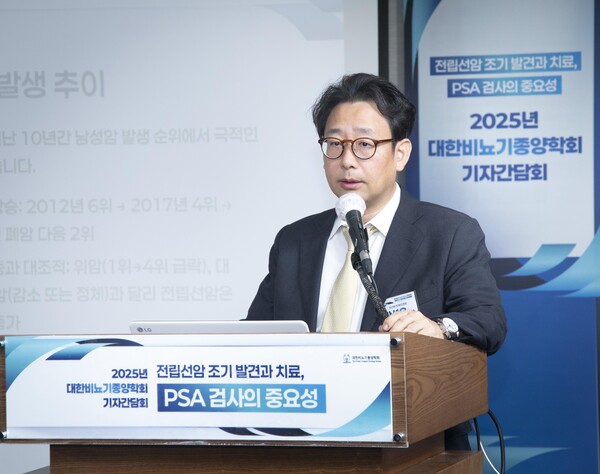Korea’s urologic oncologists are urging health authorities to close what they describe as a glaring gap in the country’s cancer policy: the absence of prostate cancer testing from the national screening program.
At a press conference in Seoul on Tuesday, the Korean Urological Oncology Society (KUOS) warned that prostate cancer has climbed to the second-most common cancer in Korean men, with more than 20,000 new cases in 2022 -- a 12-fold increase since the late 1990s. With one in five Koreans now over 65, doctors said the numbers are likely to climb further in an aging society.
“Most patients who die of prostate cancer do so because of distant metastasis. Early detection is what separates cure from decline,” said Park Sung-woo, vice president of the society and professor of urology at Pusan National University Yangsan Hospital. He noted that nearly 150,000 Korean men are living with the disease, making it the second most common male cancer after stomach cancer.

Prostate-specific antigen, or PSA, is a protein measured through a simple blood test. Elevated levels can signal prostate cancer, and in countries where PSA screening is routine, men are far more likely to be diagnosed while the disease is still localized.
According to government registry data presented Tuesday, survival rates reflect that difference: close to 100 percent when the cancer is caught early, but only about 50 percent once it spreads to the bone or lymph nodes.
In Korea, those odds are worse than they need to be. KUOS officials pointed to a national study of 71,000 patients diagnosed between 2010 and 2020, which found that more than half were already in the high-risk group at diagnosis.
The average age at diagnosis was 71, with one-third of cases in men over 75. By comparison, fewer than 10 percent of cases in the United States are classified as high risk, where widespread PSA use has shifted most diagnoses into low-risk categories.
The contrast with stomach cancer, once the country’s most common malignancy, is particularly stark. Routine endoscopy helped drive stomach cancer rates down. Prostate cancer, by comparison, “has gone in the opposite direction,” Park said. “It continues to rise every year, yet remains outside the system.”
Awareness is also low. In a 2020 survey of Korean men in their 40s to 60s, only 17 percent said they had ever taken a PSA test, and just 10 percent had even heard of it. “The cost is negligible, but the benefit is profound,” said Ko Young-hwii, professor of urology at Ewha Womans University Mokdong Hospital. “Higher survival, lower treatment expenses and reduced inequality in access are all within reach.”
Without early testing, men are often steered into systemic therapies such as hormone treatments, chemotherapy and targeted drugs. Those therapies are harsher and two to three times more expensive than localized treatments like surgery or radiation, according to a decade of insurance claims data presented at the conference.
Concerns about overtreatment have long kept PSA out of Korea’s screening program, echoing debates in the West. But Ko said the calculus has changed. Advances in active surveillance allow low-risk patients to be monitored safely, avoiding unnecessary interventions. “The tools are already here,” he said. “What we lack is the will to detect the disease in time.”
The society also noted an imbalance in how men and women are covered under Korea’s program. Women receive screening for breast and cervical cancers, while men, despite prostate cancer now ranking second among male cancers, have no equivalent safeguard. “Among the five major male cancers -- stomach, colorectal, liver, lung and prostate -- prostate is the only one excluded,” Park said.
Treatment options are evolving quickly, with new genetic tests, targeted drugs and radioligand therapies entering practice. But Park warned that high costs and regional disparities risk leaving many patients behind. “Expanding insurance coverage and support for testing will be critical to ensure equitable care,” he said.
The society said it will continue lobbying the Ministry of Health and Welfare and the National Health Insurance Service to add PSA screening for men over 50, and from 45 for those with a family history. “It is no longer a question of science,” Park said. “It is a question of policy.”
Related articles
- In hereditary prostate cancer, genetic testing of family members proves effective: study
- 3 or more PSA tests over 2 years yield favorable outcomes in prostate cancer treatment
- FutureChem's radiopharmaceutical wins MFDS approval for phase 3 prostate cancer trial
- Pfizer and J&J face new heat as Bayer’s Nubeqa racks up FDA and Korea wins in prostate cancer
- Korea sees surge in lung cancer surgeries among elderly, women: 14-year data

